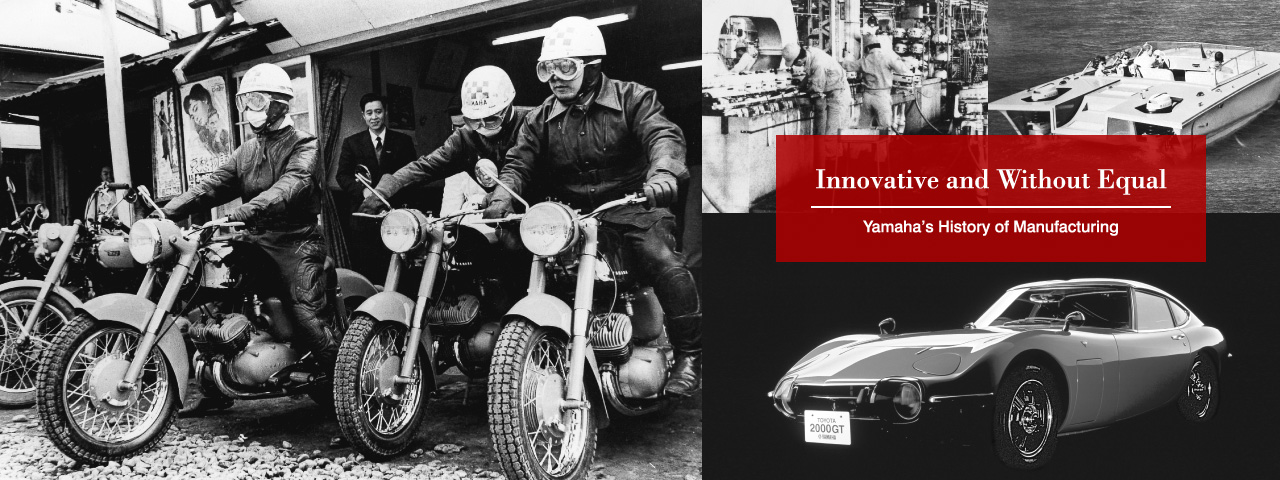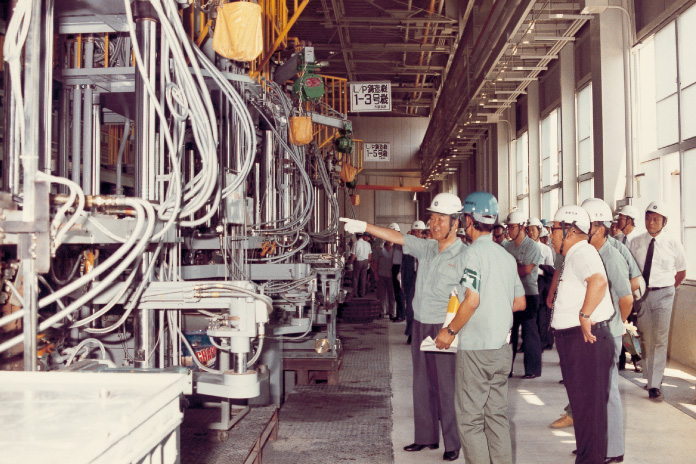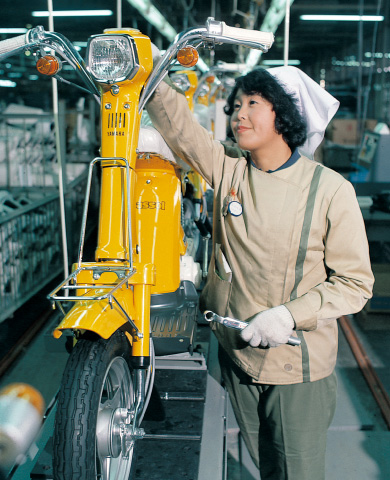Our History of Casting Vol. 4 - A Fight for Survival Forges a Corporate Culture
Manufacturing is the cornerstone of Yamaha's business and we continue to refine our casting technology. This is the story of how these technologies join the present with the future.



Of Fierce Independence and Staunch Self-Reliance
Yamaha Motor engineers are always looking for challenges.
Motorcycles are an intensely competitive industry, be it their technology or marketing,
and Yamaha's very culture of encouraging new challenges
emerged from one such competition. On the front line in that struggle
were the casting factories: the foundation of any manufacturing enterprise.
The countless technologies Yamaha had were the weapons that ensured its survival.
From the late 1960s to the 1970s, most of Yamaha Motor's young new hires knew little about casting. The casting factories of the time exemplified what the Japanese call a “3K” job: kitsui (demanding), kitanai (dirty) and kiken (dangerous). Even if that wasn't the case, none of these young people could directly connect pouring molten aluminum to making the flashy and exciting product that was a motorcycle. When first learning they had been assigned to the casting factory, most of the veteran casting engineers at Yamaha today knew nothing about what it entailed so they didn't particularly complain. “We just did as we were told as they led us by the hand, and the next thing we knew we were thrust into the casting factory!” they all recall with a grin.

In September 1981, Iwata Factory #3 took over all operations for the motorcycle casting divisions. This created a one-stop production hub for all cast part creation and formed the foundation for the subsequent development of proprietary Yamaha casting technologies.
In 1981, the casting divisions had been transferred completely from Nippon Gakki to Yamaha Motor and Iwata Factory #3 began operations, but the exchange of personnel between the two companies continued as before. Yamaha Motor's beginnings were at Nippon Gakki and they were one and the same initially, so the relationship was always very close. However, after Yamaha Motor was founded as a separate company, it eventually took on its own distinct corporate culture.
Having already earned a reputation as a top maker of musical instruments, Nippon Gakki had some leeway as a successful enterprise. In comparison, Yamaha Motor had little more than burning ambition. In Japan in those days, there were more than 200 large and small motorcycle companies and Yamaha was one of the last to enter the industry. So the company had to fight tooth and nail to survive this intense competition for domestic supremacy, and the history of this struggle―and subsequent success―formed Yamaha into the company it is today.
There was a continuous flow of various technologies and equipment from Nippon Gakki—and from other manufacturers through technical tie-ups—into Iwata Factory #3 and the Iwata Main Factory. Influenced by the market situation at the time, which will be described later, these factories were built based on a business plan for an annual production capacity of four million units. This charge headfirst to throw everything into producing motorcycles, outboard motors and automobile engine parts was out of necessity.
But even in the midst of these extremely hectic and long workdays, the inherent passion of the casting engineers kept their spirits high. “We'll do it ourselves!” was their guiding mantra. This had positives from a management perspective as well, like more efficient manufacturing, equipment and facilities that were easier to use, and creation of a production scheme with lower costs. But more than that, the young engineers' genuine enthusiasm and insistence on forging their own path with their own skills are what fostered the company culture: “How about we do it ourselves? Come on, let's do it! If it's us, we can!” That kind of passionate spirit permeated the company.
Their approach to and standards for quality were also on a different level. For example, let's say Yamaha is casting an engine part for another manufacturer in a technical tie-up. They cast the part exactly as requested and the client is completely satisfied with the quality, but the casting engineers simply aren't satisfied with the part's surface finish. Although the part may function perfectly well, the engineers feel it isn't beautiful to the eye―inexcusable. “Let's do something about it,” they say, reviewing and revising the casting plan itself in order to produce an even better part.
Developments such as the above took place countless times throughout the company and with great frequency to boot. Of course, doing this incurred additional costs, time and effort every time it happened. And since this was after the design and quality criteria had been met, there were unsurprising but understandable complaints about the engineers' “pointless and excessive obsession with quality.” However, Yamaha Motor has never been a company that put operating efficiency before all else.
Knowing nothing about casting, Yamaha Motor's new hires were dumbfounded as they were quickly sent off to the factories and assigned difficult tasks to complete. But at times, they themselves were eager for demanding problems. Failures were a given; even when ignoring the tremendous trouble, time and cost involved, it was mistake after mistake and failure after failure. And although often berated by the foreman, they succeeded in creating almost all of their molds in the end. “There are no failures if you keep trying until you succeed,” was the saying. Hardship builds knowledge and character, and it was these people forged through their struggles that went on to further Yamaha's casting technology.
One of the engineers from the time reminisces: “When I would talk about work with friends my age that had entered other companies, they were often shocked. ‘They put you in charge of all that?!’ they'd say. It really was an endless cycle of challenges and tough times, but it was always well worth the effort.”
While it was always part of Yamaha's company culture to charge engineers with whatever task needed to be accomplished, the historical background for this was also an undeniable factor. From 1979 to 1983, Honda and Yamaha engaged in a titanic struggle for hegemony that has since become a part of motorcycle industry folklore: the Honda-Yamaha War. In fact, operations at Iwata Factory #3 started right at the height of this epic clash.
The battle for market share between Honda and Yamaha was ferocious. Both companies radically augmented their mass-production capabilities and the dealership floors were characterized by escalating and seemingly never-ending price wars as the two manufacturers tried undercut each other. On the factory floors and in the marketing offices, days of high pressure and stress continued without letup, and the Honda-Yamaha War had a profound impact on Yamaha's emergent casting operations. “Buy more casting machines! A lot more!” came the calls. “Just keep churning out product and get it to the sales guys on the front lines!” Things eventually reached the point where Yamaha was producing a new mold every day, a pace so frantic as to defy description.
But in spite of this, the actual number of casting engineers was not all that high. “A smaller group becomes a talented group,” so they say. True to that, the young engineers were given full responsibility to handle whatever challenge came knocking, but as they successfully cleared each, they did indeed grow into an elite group. They threw themselves into their work without fear of failure because they had no other choice, no other path to take with the financial crisis right at their front door. For Yamaha, the war was a matter of corporate life and death that required that degree of commitment. Far removed from simply training new personnel, it was a veritable battle with the company's very future at stake.

The Passol scooter targeting women went on sale in March 1977, triggering the market boom for so-called “soft bikes” that lasted from the mid-1970s through to the 1980s.
The war ended in in 1983 and it was clear that Yamaha had suffered an ignominious defeat. However, the company had gained some very valuable assets: a fighting spirit not to shy away from daunting problems and “figure out a way to do it ourselves,” the foundation to teach and foster engineers embodying that spirit, and countless new casting technologies. (Continues in Vol. 5)
Our Business
We apologize for any inconvenience caused and we are hoping for your kind consideration.